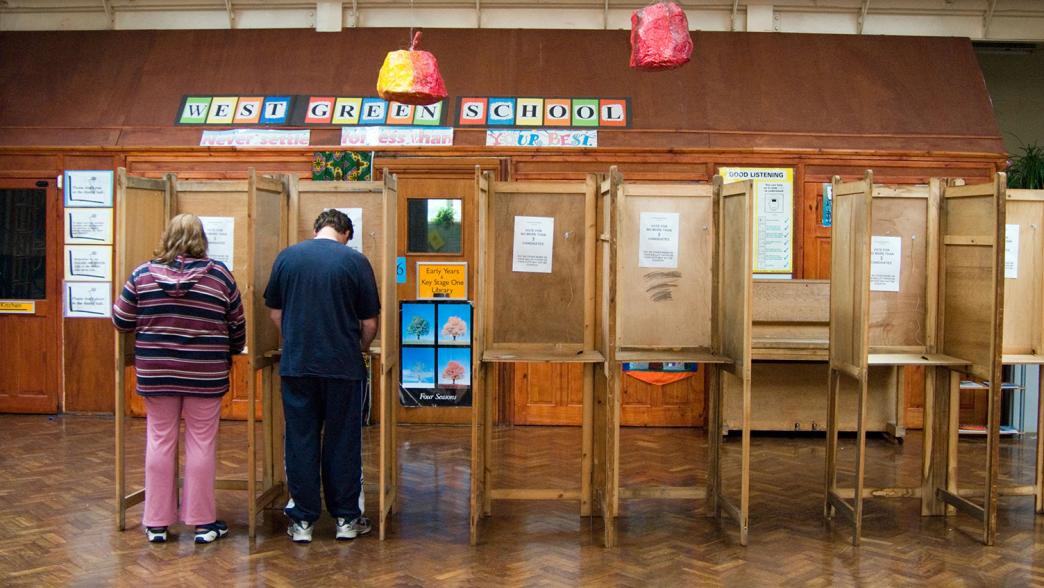
Local elections will take place in England and Northern Ireland in May.
Where are elections taking place?
Council elections are being held in 230 of England’s 317 councils on Thursday 4 May.
On 18 May elections are taking place for all 462 seats in all 11 local authorities in Northern Ireland.
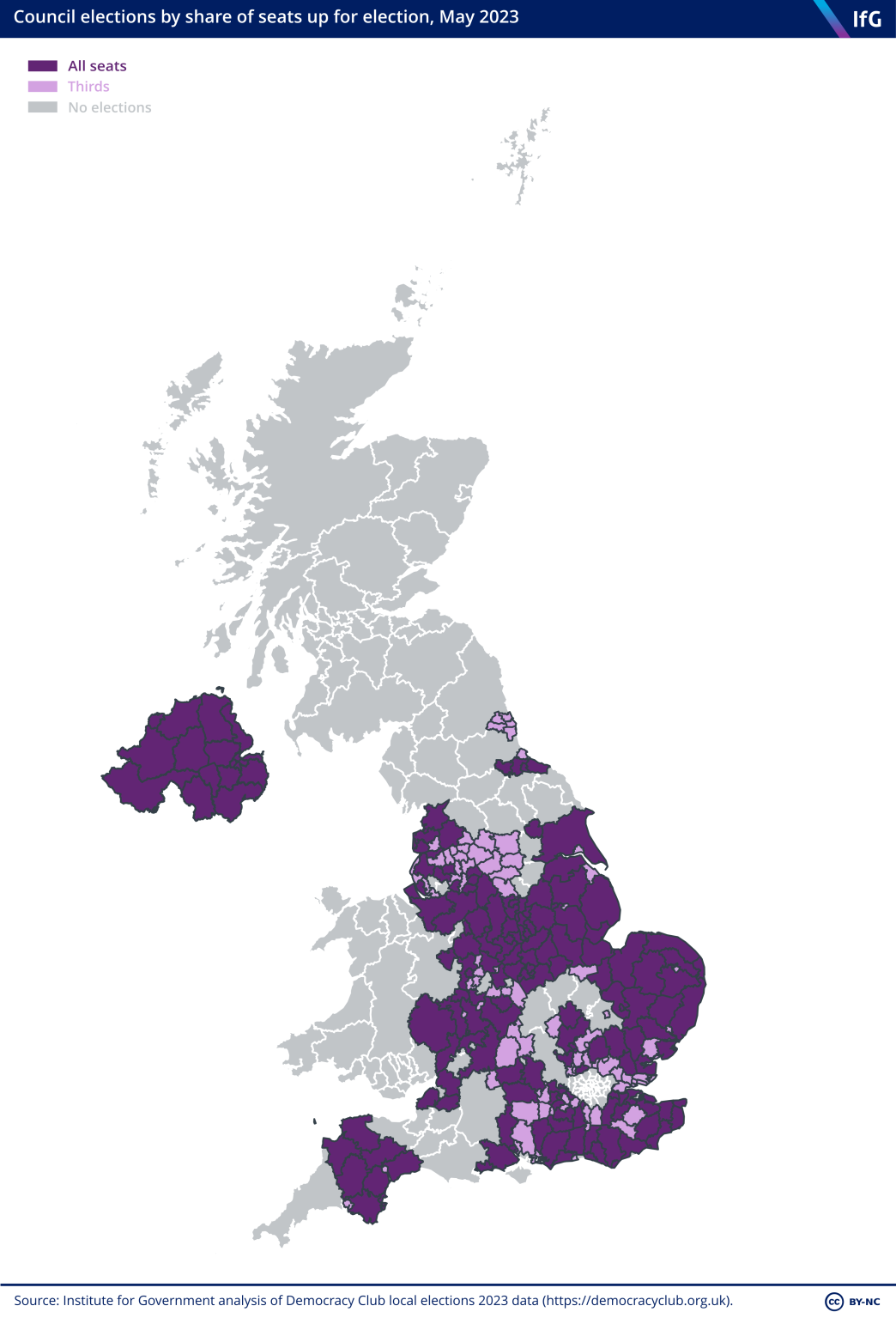
There are no elections taking place in Scotland or Wales in May 2023.
How many seats are being contested in England?
A total of 8,058 council seats are being contested on 4 May, not including any by-elections being held the same day. In England, councillors are elected on four-year terms to single or multi-member wards using the first-past-the-post electoral system (FPTP).
Unlike the other three UK nations, not all council elections in England take place in the same year. Around two thirds (67%) of councils elect all their councillors every four years; just under one third (31%) elect councillors by thirds three years out of every four. A far smaller number (2%) elect their councillors by halves every two years.
The breakdown of elections in 2023 in England is as follows:
All seats will be contested in:
- Nine metropolitan boroughs, including the cities of Liverpool and Wolverhampton
- 32 unitary authorities, including cities such as Nottingham, Derby and York
- 105 district councils, including in much of the South East, East and Midlands.
A third of seats will be contested in:
- 14 unitary authorities
- 23 metropolitan boroughs
- 47 district councils.
Local mayoral elections will take place in Bedford, Leicester, Mansfield and Middlesbrough. This group of mayors are directly-elected leaders of their local councils. These council mayoral elections will use FPTP following the implementation of the Elections Act 2022.
No metro mayors – who hold power across a wider region – are up for election this year.
What were the results in previous elections in England?
After the May 2022 local elections, the Conservative Party held 40% of all council seats in England, down two percentage points from 2021. The Labour Party won 31%, almost unchanged from the previous year, and the Liberal Democrats won 15% of seats. The Conservative Party has held the largest share of council seats in England since 2003.
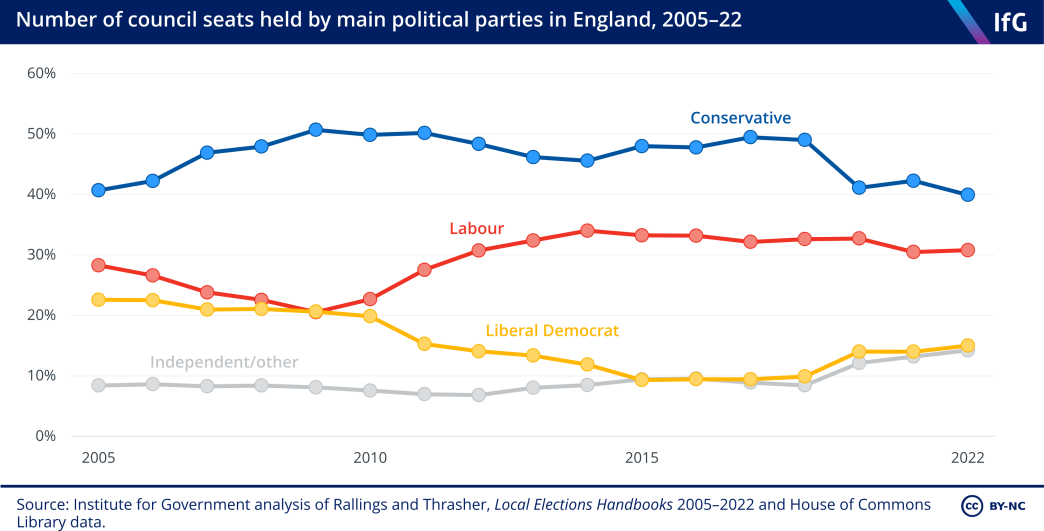
Following the 2022 elections, the Conservatives controlled 38% of councils, down four percentage points from 2021. Labour controlled 24% of councils and the Liberal Democrats 8%. Councillors from other parties and independent councillors controlled 2% of councils and the other 29% of councils were under no overall control.
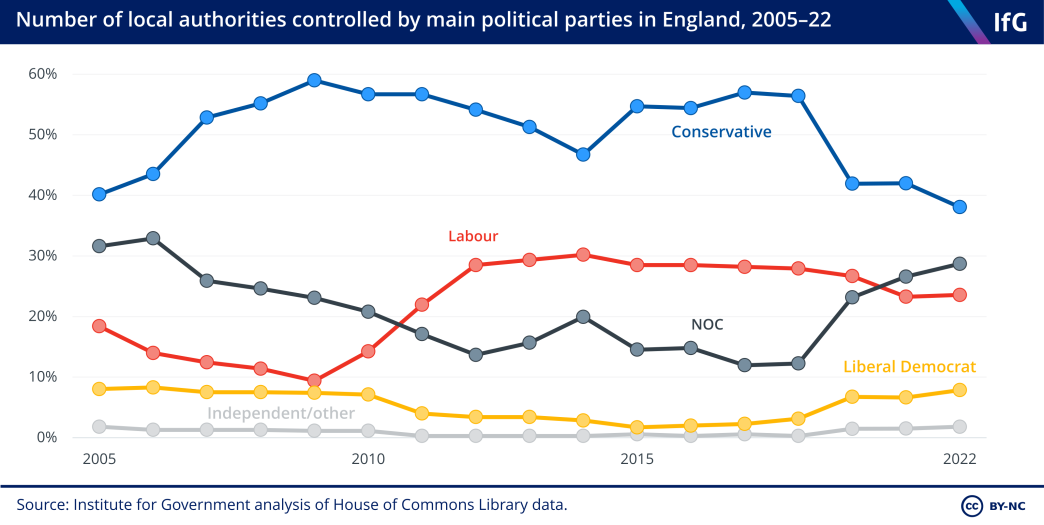
Most of the seats being contested in 2023 were last elected in 2019. At those elections, the Conservatives and Labour both received 28% of the vote while the Liberal Democrats received 19%.
What were the results in previous elections in Northern Ireland?
In 2019 elections, the Democratic Unionist Party (DUP) won 122 seats (26% of the total), Sinn Féin 105 (23%), the Ulster Unionist Party 75 (16%), the Social Democratic and Labour Party 59 (13%), the Alliance Party 53 (11%). Independents and other parties won 48 seats (10%).
Councillors are elected in Northern Ireland using the single transferable vote (STV) system. Unlike FPTP as used in England and Wales, STV results in seats being allocated in closer proportion to the number of votes won by each party. No party held a majority on any council following the last elections in 2019.
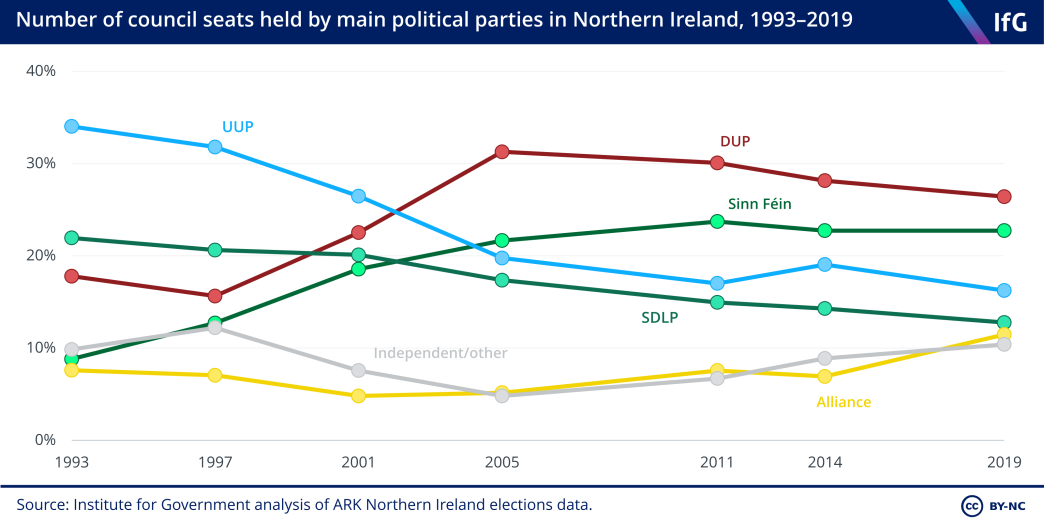
Why do these elections matter?
Many frontline public services are delivered by local councils. In England, county councils – none of which are up for election in 2023 – are responsible for social care and some aspects of transport and education. Counties are sub-divided into district councils which provide local services such as planning and waste collection.
Unitary councils provide all the functions of local government in areas where the responsibilities of county and district councils have been merged into a single authority (known as unitarisation).
In England, 14% of spending on public services (so not including public spending on transfers like social security payments) is spent through local government or equivalent to £74bn in 2020/21. 13 This excludes spending on education and police and fire and rescue services which is technically spent through local authorities although not directly controlled by them.
In some parts of England, local leaders also hold collective responsibility for powers – for instance over transport, skills and economic development – that are devolved to mayoral combined authorities (MCAs) that operate across several council areas.
There are elections in all nine areas covered at present by MCAs, including Greater Manchester and the West Midlands, where expanded ‘trailblazer’ devolution deals were recently announced.
Newly elected councillors in metropolitan boroughs in Tyne and Wear and in Nottingham, Derby and York City Councils will be responsible for ratifying and implementing the new North East, East Midlands and York and North Yorkshire devolution deals.
All Northern Ireland councils are unitary authorities but have fewer responsibilities compared to those in the rest of the UK. Councils in Northern Ireland provide some neighbourhood services such as waste collection and street cleansing. However, they are not responsible for education, libraries or social care. As a result, only 3% of spending on public services is through local authorities in Northern Ireland, or around £840 million in 2020/21.
Which are the places to watch?
Media and political attention will likely focus on the so-called “red wall” in the midlands and north of England (longstanding Labour constituencies that backed Brexit and were won by the Conservatives in the 2017 and 2019 elections) as well as “blue wall” seats in the south (Remain-voting, traditionally Conservative seats).
Both main parties will hope to make progress in Darlington where the Conservatives won two more seats than Labour in 2019 but fell short of a majority. The Conservatives will also hope to consolidate their position in Hartlepool after their parliamentary by-election victory two years ago and where they are the largest party on the council. Labour will be looking to end the Conservatives’ majority in Dudley – they both held exactly the same number of seats on the council in 2019 but the Conservatives won a majority in the elections last year.
The Liberal Democrats will be looking to repeat their strong performance last time most of these seats were contested in 2019, at the height of parliamentary battles over Brexit, by at least retaining seats gained (predominantly from the two main parties) then. They will also be looking to make gains at the expense of the Conservatives on Elmbridge Borough Council – in the constituency of recently resigned deputy prime minister Dominic Raab – as will the Greens. Also in the south, Labour will be wanting to show that they can win in Conservative-run Swindon and Milton Keynes – parliamentary seats with Conservative majorities under 10,000 but that Labour held when it was last in government before 2010.
Changes in the political control of constituent councils in mayoral combined authorities could also be worth watching. Metro mayors require unanimous agreement from council leaders to make certain decisions – Greater Manchester’s Andy Burnham has faced opposition from Stockport Borough Council over his planning framework, for example – so these elections could influence how mayors and council leaders are able to work in partnership to drive economic development and allocate investment.
Who can vote in local elections?
In England and Northern Ireland, all adults aged 18 and over can vote in local elections who are British citizens, EU citizens, or ‘qualifying Commonwealth citizens’ 14 GOV.UK, Types of election, referendums, and who can vote, www.gov.uk/elections-in-the-uk/local-government (citizens of Commonwealth countries who have leave to enter or remain in the UK, or who do not require that leave). 15 The Electoral Commission, Register to vote, www.electoralcommission.org.uk/i-am-a/voter/register-vote-and-update-your-details#commonwealth
Following the passage of the Elections Act 2022, the local elections on 4 May will be the first to take place with mandatory voter identification (ID) in England. Voters will need to show an acceptable form of photographic ID, as listed on the Electoral Commission website. Voters without photo ID had until 25 April 2023 to apply for a voter identification certificate to enable them to vote. 16 The Electoral Commission, Accepted forms of photo ID, www.electoralcommission.org.uk/i-am-a/voter/voter-id/accepted-forms-photo-id Voter ID requirements only apply to votes cast at polling stations; postal votes use different, pre-existing, signature verification.
In Northern Ireland, voters have been required to show photographic ID since 2003.
How many people vote in local elections?
Fewer people vote in local elections than in general elections. Turnout at local elections tends to be between 30% and 40% of the electorate. By contrast, turnout for elections to the UK parliament over the past five elections has averaged 66%.
Turnout in local elections in Northern Ireland is higher than in England on average, with turnout averaging 53% in the most recent three local elections. When local elections take place at the same time as parliamentary elections, as last happened in England in 2015, turnout is comparable to that of national elections.
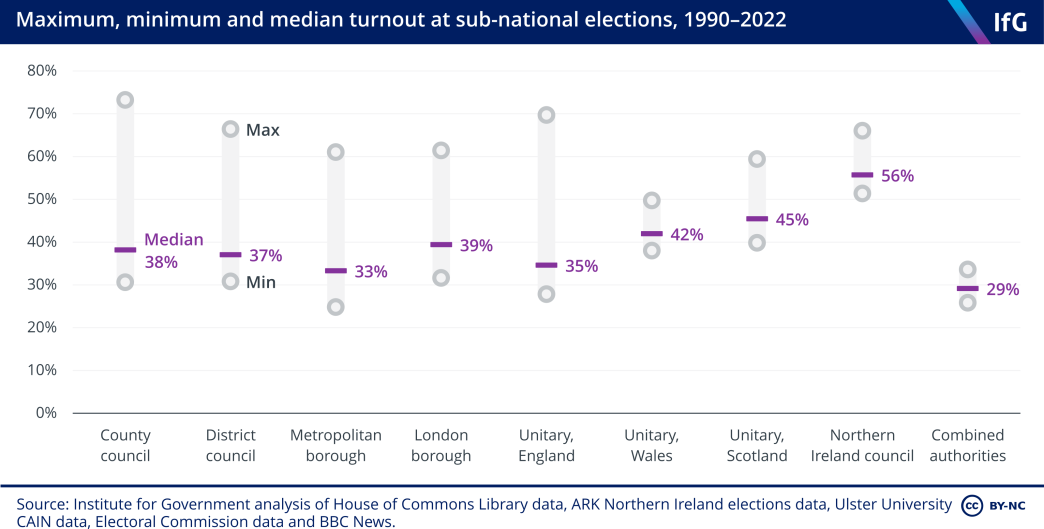
- Topic
- Devolution
- United Kingdom
- England Northern Ireland
- English Regions
- North East North West Yorkshire and the Humber East Midlands West Midlands South East South West East of England East of England
- Combined authorities
- Greater Manchester Combined Authority West Midlands Combined Authority
- Publisher
- Institute for Government